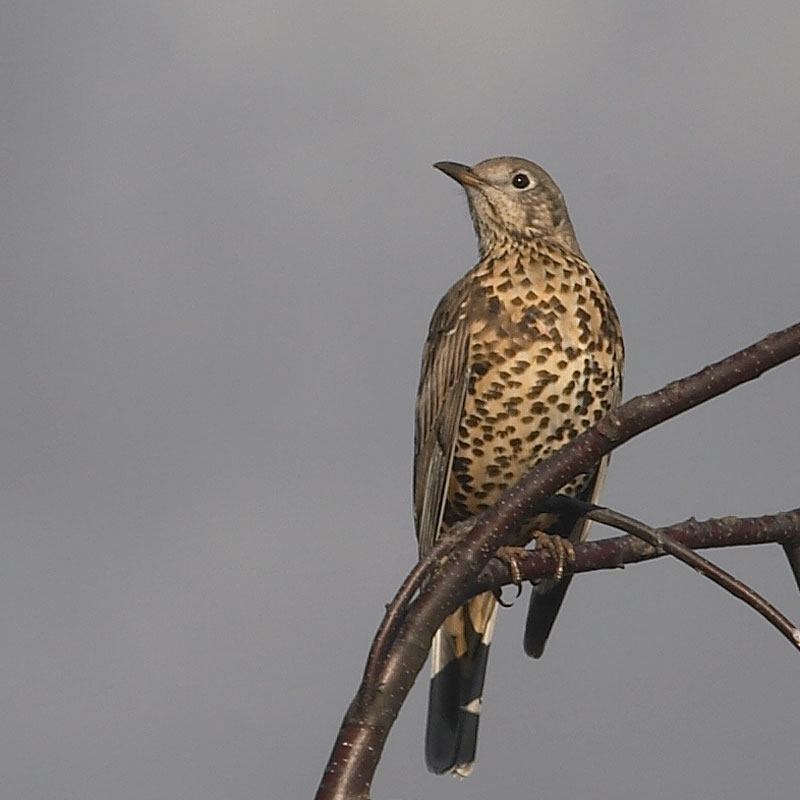Mistle thrush
(Turdus viscivorus)

Description
The mistle thrush (Turdus viscivorus) is a bird common to much of Europe,Asia and North Africa.It is a year-round resident in much of its range,but northern and eastern populations migrate south for the winter,often in small flocks.It is a large thrush with pale grey-brown upperparts,a greyish-white chin and throat,and black spots on its pale yellow and off-white underparts.The sexes are similar in plumage,and its three subspecies show only minimal differences.The male has a loud,far-carrying song which is delivered even in wet and windy weather,earning the bird the old name of "stormcock".Found in open woods,parks,hedges and cultivated land,the mistle thrush feeds on a wide variety of invertebrates,seeds and berries.Its preferred fruits including those of the mistletoe,holly and yew.Mistletoe is favoured where it is available,and this is reflected in the thrush's English and scientific names;the plant,a parasitic species,benefits from its seeds being excreted by the thrush onto branches where they can germinate.In winter,a mistle thrush will vigorously defend mistletoe clumps or a holly tree as a food reserve for when times are hard.The open cup nest is built against a trunk or in a forked branch,and is fearlessly defended against potential predators,sometimes including humans or cats.The clutch,typically of three to five eggs,is incubated for 12–15 days,mainly by the female.The chicks fledge about 14–16 days after hatching.There are normally two broods.There was a large range expansion in the 18th and early 19th centuries,although there has been a small decline in recent decades,perhaps due to changes in agricultural practices.Given its high numbers and very large range,this thrush is classified by the International Union for Conservation of Nature as being of least concern.The mistle thrush is the largest thrush native to Europe.The nominate subspecies measures 27–28 cm (11–11 in) in length,with a 45 cm (18 in) wingspan.It weighs 93 to 167 g (3.3 to 5.9 oz),with an average of around 130 g (4.6 oz).It has a stocky upright posture when on the ground.It has pale grey-brown upperparts,the chin and throat are greyish-white,and the yellowish-buff breast and off-white belly are marked with round black spots.The spotting becomes denser on the lower chest,giving the appearance of a breast-band.The long tail has white tips on the outer feathers,and the underwing coverts are white.The eyes are dark brown and the bill is blackish with a yellowish base to the lower mandible.The legs and feet are yellowish-brown.There are no plumage differences between the sexes.Juveniles are similar to adults,but they have paler upperparts with creamy centres to many of the feathers and smaller spots on the yellowish underparts.By their first winter they are very similar to adults,but the underparts are usually more buff-toned.The eastern subspecies T.v.bonapartei is 30 cm (12 in) in length,and therefore slightly larger than the nominate form.It is paler grey above and whiter below,with fewer black spots.Birds of intermediate appearance are seen west of the Ob River where the range overlaps with viscivorus.The southern race T.v.deichleri resembles bonapartei in appearance,but is closer in size to the nominate viscivorus,although it has a more slender bill.Adults have a full moult after breeding,beginning between late May and the end of June,and completed by early October.Juvenile birds have a partial moult,replacing their head,body,and covert feathers;this is completed by October,although the start of the moult depends on when the chicks hatched.The mistle thrush is much larger,paler and longer-tailed than the sympatric song thrush.In the western Himalayas it could be confused with both the plain-backed and the long-tailed thrushes.These are similar to the mistle thrush,but the plain–backed thrush lacks obvious wing bars,is more rufous above than its relative,and is barred rather than spotted below.The long-tailed thrush has olive-toned upperparts,bars on its breast and two wing bars.Juvenile mistle thrushes are superficially similar to White's thrush,but that species has golden-yellow plumage,scalloped underparts and a distinctive underwing pattern.
Taxonomic tree:







